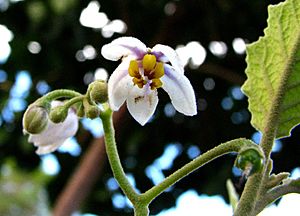Hawai'i horsenettle facts for kids
Quick facts for kids Hawai'i horsenettle |
|
|---|---|
 |
|
| Conservation status | |
| Scientific classification | |
| Genus: |
Solanum
|
| Species: |
sandwicense
|
Solanum sandwicense is a very special and rare plant. It's also known as the Hawai'i horsenettle or popolo 'aiakeakua. This plant is a type of shrub that only grows in Hawaii. You can find it on the islands of Kauai and Oahu. It's an endangered species, which means it's in danger of disappearing forever.
Contents
About the Hawai'i Horsenettle
This plant is a shrub that can grow quite tall. It can reach up to 5 meters (about 16 feet) high. Its main stem can be as wide as 15 centimeters (about 6 inches). The plant is covered in soft, yellow-brown hairs.
What it Looks Like
The leaves of the Hawai'i horsenettle are oval-shaped. Sometimes, they have a few gentle curves or lobes. They can be up to 15 centimeters long and 14 centimeters wide.
The plant produces beautiful flowers. They grow in a group called an inflorescence. Each flower is about 2 to 2.5 centimeters wide. They are a pretty white color with hints of purple. The flowers also have bright yellow parts called anthers.
After the flowers bloom, they turn into fruit. The fruit is a round, juicy black berry. Each berry is a little over a centimeter wide.
Where it Lives and Why it's Rare
The Hawai'i horsenettle is a plant that is endemic to Hawaii. This means it naturally grows nowhere else in the world. Sadly, it used to grow on the Big Island of Hawaii, but it no longer does. This is called being extirpated from that area.
On the island of Oahu, the very last wild plant died in the 1990s. Luckily, scientists saved some of its seeds. They used these seeds to grow new plants. These new plants were then carefully planted back into safe areas. Today, there are fewer than 20 wild plants left on the island of Kauai.
Threats to its Survival
Many things threaten the Hawai'i horsenettle. Animals like feral pigs, feral goats, and mule deer eat the plants. Rats and slugs also munch on them.
Another big problem is invasive species of plants. These are plants that are not native to Hawaii. They grow very fast and take over the habitat. Examples include Kalanchoe pinnata (also known as air plant) and Passiflora tarminiana (banana poka). These invasive plants make it hard for the Hawai'i horsenettle to grow and thrive.


